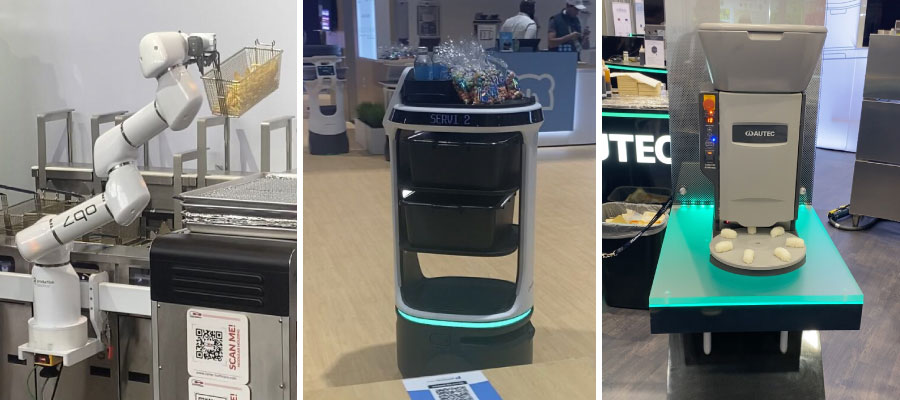
Future of Foodservice: 5 Key Trends Shaping the Dining Experience
Insights from the National Restaurant Association Show
Estimated Read Time: 5 Minutes
At this year’s National Restaurant Association Show, industry leaders and innovators gathered to showcase the latest trends transforming the foodservice landscape. Among the myriad insights presented, five key trends stood out: consumers craving convenience, an eagerness for experiences, an appetite for adventure, a will for wellness, and sincerity towards sustainability These trends reflect the evolving preferences and values of today’s consumers, pushing the foodservice industry towards more dynamic, personalized, and responsible practices.
1. Consumers are Craving Convenience
With busier schedules and more demands on time, consumers are prioritizing convenience in their dining experiences. They are seeking dining options that fit seamlessly into their fast-paced lives without sacrificing quality. Amid the demand for quick, efficient service options, restaurants are stepping up to the plate with innovations in features like ghost kitchens, mobile ordering and payment apps, meal kit services, drive-thru and curbside pickup, and the introduction of automation and robotics.

Read more about our perspective on convenience in dining here and here.
By focusing on these innovations and continuously adapting to consumer needs, foodservice providers can effectively tap into the trend of craving convenience, ensuring they remain competitive and relevant in a changing market.
2. Eagerness for Experiences
Beyond convenience, consumers are increasingly seeking dining experiences that go beyond just eating; they want memorable experiences that provide emotional connection. This trend focuses on enjoying immersive, unique outings that can’t be replicated at home including themed restaurants, pop-up dining events, and interactive and multi-sensory dining elements.
One notable innovator in this space is EatWith, a "table sharing" app that connects diners with local hosts who provide authentic culinary experiences in their home. It’s an opportunity to learn about regional ingredients, customs, and cuisine in an intimate setting.

By focusing on creating unique, memorable experiences, foodservice providers can tap into the trend of eagerness for experiences, attracting consumers who seek more than just a meal, but an unforgettable culinary journey.
3. Appetite for Adventure
There is a growing consumer interest in stepping out of their comfort zones to try new and innovative flavors. This adventurous spirit is reshaping the foodservice industry, pushing it towards greater creativity and diversity in menus. Innovations in this area include fusion cuisine, rotating menus, foraged and rare ingredients, and themed food events and pop-ups.
40% of consumers are more than willing to visit a restaurant offering new innovative flavors1
A notable brand making headway in this space is KITTCH, a platform that offers access to culinary wisdom from chefs around the world, providing inspiration for adventurous cooking and dining. Users can learn about new ingredients and techniques from culinary experts.

By understanding the drivers behind consumers’ appetite for adventure, restaurants can attract consumers eager for new and exciting culinary experiences and foster a deeper connection between consumers and the rich diversity of global cuisines.
4. A Will for Wellness
Consumers are increasingly prioritizing their health and wellness, seeking foods that not only taste good but also contribute to their overall well-being. This trend encompasses a holistic approach to health, and emphasizes mindful eating practices, where consumers are more aware of what they consumer and how it affects their health.
41% of consumers are more likely to try new and unique flavors if there are health benefits.1
Key drivers of this trend include the rise of chronic diseases, growing mental health and overall well-being awareness, and technological advancements including wearable devices and health apps that make it easier for consumers to track health metrics and make informed dietary choices.
Related: Unlock the Power of Healthables
Related: Food Is Medicine
Two standout brands making innovative strides towards health-focused foodservice include Viome and Zoe. Viome provides personalized nutrition recommendations based on an individual’s microbiome analysis. By understanding the unique composition of gut bacteria, Viome helps consumers optimize their diets for better health. Zoe uses continuous glucose monitoring and personalized dietary analysis, offering insights into how different foods affect an individual’s blood sugar levels. This data-driven approach helps consumers make healthier food choices based on their unique needs.

By embracing this trend, foodservice providers can attract health-conscious consumers who are seeking nutritious and mindful dining options, supporting not only individual health but also promoting a broader culture of well-being.
5. Sincerity Towards Sustainability
Sustainability is becoming a key factor in consumer decision-making as consumers increasingly seek foodservice options that prioritize sustainable practices, including reducing food waste, using eco-friendly packaging, and sourcing ingredients responsibly.
Over 80% of consumers say reducing food waste/food loss reduction is an important sustainability issue.1
1 in 3 consumers say promotion of recycling/waste-reduction influences their foodservice venue decision.1
75% of operators say sustainability will become important.1
One notable restaurant brand taking this challenge to heart is Chipotle, who is piloting a new restaurant design that uses all-electric equipment and incorporates renewable energy sources into their operations. This initiative is part of their broader sustainability campaign focused on reducing their environmental impact.

By focusing on innovations like sustainable sourcing and menu design, eco-friendly packaging, and energy-efficient practices and technology, restaurant brands can meet the growing consumer demand for environmentally and ethically responsible practices. This trend not only benefits the planet but builds trust and loyalty among consumers who value sustainability.
Looking Ahead: Embracing the Future of Foodservice
The National Restaurant Association Show highlighted the pivotal trends shaping the future of foodservice. As consumers increasingly seek convenience, memorable experiences, adventurous flavors, wellness-oriented options, and sustainable practices, the industry must adapt to meet these demands. Embracing these insights not only enhances customer satisfaction but also fosters innovation and sustainability in the foodservice sector, ensuring a thriving and resilient future.
Adding to these 5 callouts, we believe that the integration of artificial intelligence (AI) into restaurant operations is a necessity for staying competitive. Go deeper into how your brand can harness the power of AI to enhance efficiency, streamline processes, and deliver a superior dining experience for consumers in our POV, Leveraging AI to Drive Operational Harmony. Read it here!

 Zach Pappas
Zach Pappas Rob Seely
Rob Seely Joanne Heyob
Joanne Heyob


